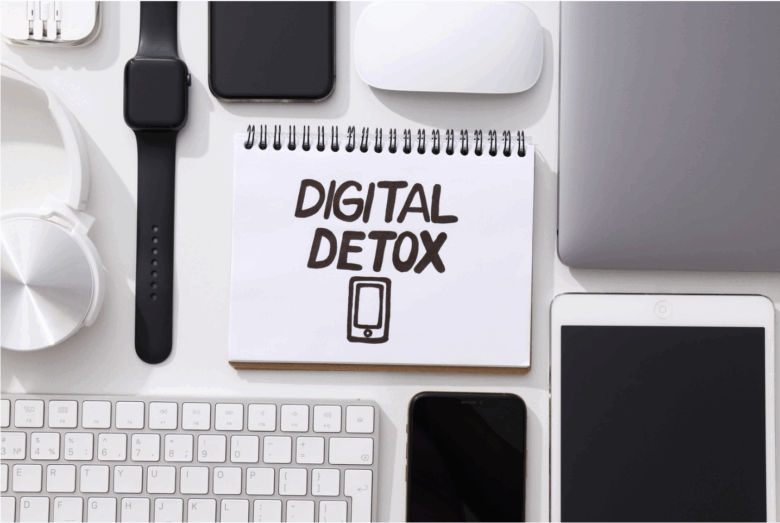Digital detox is a period in which people stop using digital tools such as tablets, laptops, and phones to reduce stress and focus on real connections. In modern society, where technology has become a necessity for entertainment, communication, and business, constant connectivity can lead to fatigue, anxiety, and sleep problems. Getting away from screens allows people to reset their brains and reconnect with others and themselves. Interestingly, while the idea is to disconnect from technology, some digital tools and apps can actually facilitate this process in a more organized and effective way.
Set Goals with Technology Support
Clear goals can help people prepare for a digital detox; technology can help with this. Many apps allow users to track screen time, measure app usage, and set goals to reduce the time they spend online. These tools provide a visual representation of digital behavior, enabling individuals to identify areas for improvement. For example, someone might not know they spend four hours a day on social media until the app shows them. People who apply this insight can set more realistic goals for their digital detox, such as limiting the use of specific apps or avoiding screen time after a certain time.
Set Good Limits with App Limits
Using app limits and screen time limits is a smart way to help with a digital detox. Many tablets and phones have built-in features that allow users to set daily time limits for specific apps. The app pauses for the remainder of the day once it reaches the limit. These limits help consumers reduce mindless screen scrolling and become more mindful of their device usage. People who rely on technology to enforce these limits are more likely to stick to their detox plan and focus on non-digital activities, such as reading, exercising, or spending time with family.
Use Wellness Apps to Change Mindless Screen Scrolling
A digital detox is more about using technology more mindfully than avoiding it altogether. Wellness apps that encourage mindfulness, meditation, and relaxation are great tools during a detox. Using guided meditation apps, breathing exercises, or listening to nature sounds can help users relax their minds instead of obsessing over social media. These alternatives offer the benefits of digital help without the distractions that most connected systems sometimes bring. Over time, switching from scrolling to calming activities can help reduce anxiety and build a better relationship with screens.
Tech Tools to Manage Notifications and Distractions
Constant reminders can be a serious barrier to a proper digital detox. Fortunately, there are tech tools that can help manage and reduce these distractions. While a device’s built-in “Do Not Disturb” function can temporarily block calls and messages, notification management apps can mute alarms for specific periods of time. These tools give people enough time for socializing, leisure, or work. Limiting the digital noise of the outside world helps people focus on the present moment and alleviates the mental fatigue that comes with constant online activity.
Create Screen-free Zones with Smart Home Devices
Smart home technology can also promote digital detox by enabling screen-free settings. For example, smart plugs can be configured to turn off gaming consoles or TVs before bed. Smart light bulbs can change color to remind users when to unplug, encouraging positive habits. Using a smart speaker in the bedroom as an alarm clock or screen-free music player can help resist the urge to check your phone before bed. These small changes to your environment can help boost the detox process by helping you better balance your digital and offline lives.
Tracking Progress to Stay Motivated
Every goal—including digital detox—relies on ongoing progress monitoring. Health dashboards and screen time tracking solutions provide daily or weekly insights into progress. These graphical overviews show trends, such as a decrease in phone use or an increase in time spent on healthy activities. Seeing progress motivates people and reminds them that work changes everything. To encourage positive behavior and create a sense of accomplishment, some apps even give users badges or motivational notes.
Balancing Digital Detox Goals with Work
Many people find technology essential to their work, which can make a detox program seem daunting. But technology solutions can help people balance personal health with work commitments. Time management tools like the Pomodoro Technique can create regular work hours and provide breaks between tasks. Focus apps can provide access to essential work tools while blocking distracting websites. These techniques can motivate people to use screen time more effectively and reduce digital fatigue. Optimizing work time can help people unwind in their personal time and focus on rest, hobbies, or family.
Embracing a Digital Wellness Lifestyle
Digital detox shouldn’t be a one-time event but part of a broader lifestyle shift toward digital wellness. Technology tools, combined with practical techniques, can help people develop lasting behaviors that promote mental clarity, physical health, and emotional balance. Over time, users will see the benefits of less screen time: better sleep, stronger relationships, more creativity, and more. When used wisely, technology can support this better lifestyle by acting as a tool. The trick is to view technology as a tool, not a constant distraction; it should be a partner in creating space.
Conclusion
While many people feel overconnected and overwhelmed, technology can also be a solution. When used wisely, technology tools can empower people to plan, monitor, and sustain digital detoxes, which can significantly improve their quality of life. From smart home devices and productivity tools to screen time trackers and wellness apps, technology can help guide people toward better behavior without completely disconnecting from the digital world. The idea isn’t to eliminate technology but to use it intentionally, leaving more room for relaxation, focus, and real-life interaction. When done in the right proportions, a digital detox can be a great way to reset and regain control of your daily life.
FAQs
1. What is a digital detox?
A digital detox is a conscious step away from screens and digital tools designed to reduce stress, improve focus, and wake people up to real life.
2. Can a digital detox really benefit from technology?
In fact, technology offers several tools to improve digital behavior, such as app limits, screen time tracking, health apps, and reminders.
3. Do I have to stop using all screens to detox?
Not always. The goal is to reduce unnecessary screen time and use technology more consciously, not to avoid it completely.
4. How long should someone do a digital detox?
Personal goals dictate the length of time. Some people take a few days or weeks off, while others do a short “detox” of a few hours a day.
5. Why a “digital detox”?
A “digital detox” can help improve your sleep, relieve anxiety, increase your productivity, improve your focus, and strengthen your relationships.




